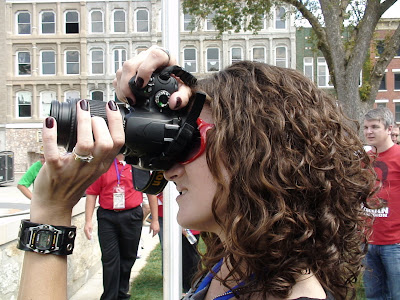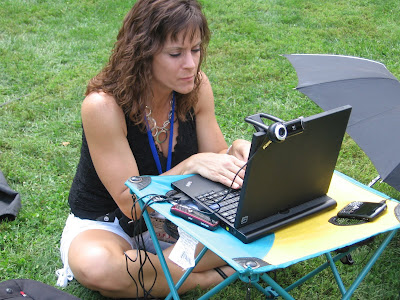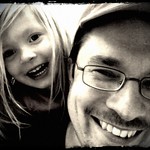The YouTube playlist above is my complete video coverage of the Quincy 912 Project. All of the videos are linked in order below:
- McKenzie Fairley singingthe National Anthem for an early sound check
- The Scott Ford Band out of Kansas City, MO, were on stage for at least an hour. I've only got two of their songs online.
- Mayor John Spring of Quincy welcomes the crowd followed by the invocation and pledge of allegiance
- McKenzie Fairley sings the National Anthem at the Quincy 912 Project
- A local teen talks about getting involved in the Tea Party movement and the 912 Project
- Andrew Breitbart speaks about American exceptionalism and the end of legacy media in his first speech at the Quincy 912 Project. He continues with observations about the Army of Davids that has risen to challenge media bias.
- Singer/Songwriter Jon David sing I'm American Made (after some mic problems)
- Roger Stone tells how he is inspired by the conservative movement of the Tea Parties. He also talks about fiscal responsibility.
- State Rep Jill Tracy speaks about freedom
- Rep. Aaron Schock (R-IL) speaks about truthfulness and delivering on campaign promises in the context of cap & tax, the healthcare debate, and good governance
- Local businessman Mike Nobis speaks against cap & tax
- Michael Patrick Leahy speaks about Saul Alinsky's influence on the left and Barack Obama
- Quincy city council woman Jennifer Lepper speaks on the importance of limitted government and self-reliance
- Ed Martin who is exploring a Congressional bid against Russ Carnahan (D-MO), tells the crowd that "freedom is making a comeback"
- Rep. Blaine Luetkemeyer (R-MO) speaks about freedom and individual liberty. He continues by emphasizing the importance of each person getting involved in the political process.
- John Loudon speaks at the Quincy 912 Project about "when" and "we" and the historical significance of the 912 Project and the tea party movements.
- Bill Hennessy, co-leader of the St Louis Tea Party, speaks out against the coastal elites and the importance of capitalism to innovation and freedom.
- Gina Loudon talks about the historic perseverance of the Tea Party movement and 912 Project
- Kevin Jackson, author of The Big Black Lie, speaks about his personal history, racism, and the contradictions of liberal logic
- Jim Hoft, the GatewayPundit, talks about the recent departure of Van Jones and Obama's "fix" for the economy and unemployment
- Christina Rassmussen talks about her work for the Illinois Policy Institute
- Comedian Tim Slagle entertains the crowd with jabs at the president and taxes
- Bobby Schilling is running for congress in IL-17 to reign in government spending
- Dana Loesch, co-leader of the St Louis Tea party and radio personality on 97.1 FM, speaks of a new kind of revolution
- Michael Johns, explains that the forces of good are aligned with liberty and the forces of evil are aligned with tyranny
- Warren Mosler speaks about his qualifications and goals for his presidential bid in 2012
- Glenn Reynolds, the Instapundit, speaks about America's history of the people rising to challenge authority tracing the Tea Party movement and 912 Project back to the Revolution
- Andrew Breitbart declared war on the media elites: "You want a war... a war it is that you are going to get."
The Quincy 912 Project was a lot of fun. I got some good pictures, met some big name bloggers (including the Instapundit, Glenn Reynolds), and enjoyed hanging out with friends from protests past. I think my favorite picture from the event is this one of Dana. Since she spends a lot of time in front of the camera, you may not realize that Dana Loesch is quite a good photographer, too.
While two of the St Louis Tea Party videographers headed off to DC, we still had a strong presence in Quincy. Sharp Elbows, Paulette Revere, and Michelle Moore (pictured below) were all rolling film. There were others as well and our still camera contingent was well represented.
Glenn Reynolds interviewed me for PJTV. He asked me where I thought the Tea Party movement was headed and I said shareholder meetings of publicly traded companies. I have no idea if they'll use that video, but it was awesome to finally meet the Instapundit! I also saw Jim Hoft, the Gateway Pundit. The first time I met Hoft he went off on how he doesn't know how Glenn Reynolds can be so prolific. He was truly exasperated. Yeah, me too. I've had like three posts this week and Glenn's probably closing in on three hundred. Hoft's probably taken down another czar. Here's a shot of them:
I provided some live coverage of the Quincy 912 Project via twitter. My twitter coverage consisted mostly of single quotes from the speeches accompanied by a picture sent to twitpic.com. Here are my tweets from Quincy:
- On my way to the Quincy, IL, #912project. I'll get lots of video! #tcot
- Slow down 30MPH thru Marblehead on way to Quincy #912project. Thanks Mr Policeman!
- http://twitpic.com/hgb9n - Sound check at Quincy #912project and #teaparty where the Scott Ford Band will be performing live.
- http://twitpic.com/hgrn9 - Glenn Reynolds groupie (me) interviewed by the Instapundit at Quincy #912project and #teaparty for @pjtv #tcot
- http://twitpic.com/hh0jx - Andrew Breitbart sporting #brooksbrothers jacket at Quincy #912project and #teaparty mentions 2,000,000 in #DC
- Andrew Breitbart: The American people ARE the Fourth Estate. Quincy 912project and #teaparty
- http://twitpic.com/hh58j - Roger Stone speaking at Quincy #912project and #teaparty. Reports 2,200,000 in #DC
- http://twitpic.com/hhban - Michael Patrick Leaahy, author of Rules for Conservative Radicals, at Quincy #912project and #teaparty: speaking on American exceptionalism
- http://twitpic.com/hheib - Ed Martin: Freedom is making a comeback! At Quincy #912project and #teaparty
- http://twitpic.com/hhh8q - If not now, when? If not us, who? John Loudon speaking at Quincy #912project and #teaparty
- http://twitpic.com/hhj50 - Taxes and regulation make us slaves to the state: Bill Hennessy at Quincy #912project and #teaparty
- http://twitpic.com/hhl03 - We fight on! Dr Gina Loudon at Quincy #912project and #teaparty #tcot
- http://twitpic.com/hhmz7 - on Biden as VP-at least we'll always know where the village idiot is: Kevin Jackson, theBlackSphere.net, at Quincy #912project and #teaparty
- http://twitpic.com/hhqc0 - One week ago Van Jones resigned: Jim Hoft says to roaring crowd at Quincy #912project and #teaparty
- http://twitpic.com/hhw4p - We have a new kind of revolution happening: Dana Loesch at Quincy #912project and #teaparty
- http://twitpic.com/hi09l - Blogger braintrust: instapundit and gateway pundit at Quincy #912project and #teaparty @pjtv
- http://twitpic.com/hi4ic - 2 million blades of "#astroturf" on the Mall today: Instapundit, Glenn Reynolds at Quincy #912project and #teaparty
I took my usual camera equipment:
- Canon A520 point-n-shoot
- Two Traveler DV-5000 flip-like video cameras
- Sony HDR-HC1 video camera
- Cowon iAudio U2 MP3 player/recorder
- Treo 650 cellphone
- Camera Tripod
The shim could never hold my HDR-HC1 especially with the extended battery. My flip-like cameras are light enough that the shim can bear their weight easily. Yeah, a second tripod isn't that expensive, but where's the fun in that?
I haven't paid much attention to audio over the past several months. The flip-like video cameras have sub-par mics and only record mono. I'm usually setup close enough to an amp/speaker that clipping (exceeding the top end of the mic's range) can be a problem. My audio issues really came home at the Labor Day Tea Party in Union, MO. The audio from one song was brutal, so I decided to try something at the Quincy 912 Project to improve my audio quality.
I found the guys running the sound board for the PA system and asked if I could record off their master to my MP3 recorder. They said ok, but I needed a cable. They handed me a bag of spare cables. After looking through the bag I was able to assemble something that would get me the left channel. Not perfect, but useful.
That recording worked as a kind of safety net. I was late starting my video of Gina Loudon; however, I was able to reassemble her speech using still photos to fill in the visual hole and my MP3 audio track from the main mixing board. During the second part of Kevin Jackson's speech, the batteries on both of my flip-like cameras quit. I switched to my Sony, but there was a gap that had to be filled with the audio from the MP3 recording (and the disturbing spackle of still photos).
While the recording off the board was helpful, it wasn't as good as I had hoped. There's almost no crowd noise on that recording. The podium mic is gathering the sound, and it doesn't pick up the crowd. My recorder captures MP3s at a maximum of 128kbps which may also result in some quality issues. I'm sure I'll do this again at other events. In fact, I've loaded my bag with the audio cables I'll need to get stereo sound next time!
What's Next
There are several memorable lines from Quincy. Two of those lines capture the revolutionary idea of a journalistic army of Davids:
- Breitbart: "The American people ARE the Fourth Estate."
- Dana: "We have a new kind of revolution."
One failure of old media has been to distort truth with their video editing decisions. I recognize that a five hour event has to be boiled down to 90 seconds for the evening news; however, I would like to see hyperlinked video. When you're watching those 90 seconds, you should be able to click-through to the source video and watch it all. I applaud Breitbart and BigGovernment.com for posting the full audio of their undercover investigation. I hope they're working on the technology that would enable what I've just described.
Video collaboration has to improve (and it is, slowly) I suspected that I was the only person recording audio off the mixing board. I mentioned this to David Vickers who was working with Glenn Reynolds/PJTV and he asked for a copy knowing that he had a hole in his coverage from earlier in the day.
The next step for video collaboration is "scalability." Something is scalable, if, when you add one more unit, it takes less time or efficiency improves in some other way. Shooting video is scalable—add a camera and you can shoot more video. Uploading video is scalable—each person uploads their video using their own Internet connection so it's all uploaded simultaneously. Annotating (adding a title, comments, and keywords to) each video is scalable, but assembling a YouTube playlist is NOT scalable (it's also not that much work).
I'd like to see conservative groups become hobbyist videographers. They are the Fourth Estate. I know of a couple groups in the St Louis area that would be great for this. I'd recommend the group agree to get one kind of camera, but this is not a strict requirement. If you're price conscious (like me), look at the store circulars in your area. As a point of reference, I bought my first Traveler DV-5000 at Aldi (yes, Aldi) in November 2008 for $100. In January or February, Aldi put them on clearance and I got my second one for $70. About a month ago, I noticed that BigLots had a flip-like camera on sale for $35.
The downside of the flip-like cameras is that they have a fixed focal plane which means that they can't zoom (never use digital zoom). That is why I always setup as close to the stage as possible. You may also want to buy memory cards and tripods. In theory, I can record over two hours of 720p video on an 8GB card. My experience has been that the camera battery dies after an hour and a half, long before the card is filled. (FWIW, 720p is the best resolution that YouTube supports at the moment, so don't shoot in a better resolution like 1080i or 1080p because it will just be more data for you to upload and YouTube to down sample.)
Coordinate with one another to live cut an event. Label your cameras (I use masking tape and a sharpie). You may want to take notes on the speakers so it's easier to annotate your videos once they're uploaded. Agree on a file naming scheme and who's responsible for organizing the YouTube playlist. If your group has regular meetings, you may want to setup the playlist at one of them. And leave a note in the comments below about your work!
Cross Coverage:
- Keyboard Militia has photos and more photos
- Michelle live streamed it and got some pictures
- Gateway Pundit has pics and video
- Sharp Elbows StL documents the failure of government schools and also got some great pics and video
- Dana's got pictures and video and everything
- The Quincy News covered it
- Paulette Revere has video on her YouTube channel
- Glenn Reynolds reports on his Quincy experience
- The St Louis Tea Party thanks Quincy
- POedPatriot and ConservativeTVOnline went to DC















1 comment:
AHAHAhhaa...LOL Come on DSM..I know you aren't so Cheap that you won't Buy another Ti-Pod. I will ask Santa to bring you one for Christmas. We can't have you embarassing the Group with the Duck tape and Sticks...
lol...
Good Article.
Post a Comment